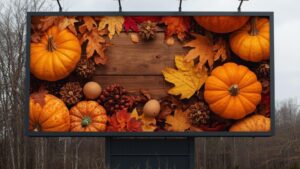How Traffic Patterns Influence Billboard Success
Billboard advertising is all about location, visibility, and audience reach—and few factors impact those elements more than traffic patterns. Whether targeting drivers on busy highways, commuters in metro areas, or pedestrians in urban centers, understanding how people move through a city is key to maximizing the effectiveness of outdoor advertising.
In this blog, we’ll explore how traffic data, rush hour trends, and commuter behavior influence billboard locations and performance for campaigns.
Why Traffic Patterns Matter in Billboard Advertising
Billboards work best when they are placed where people are already looking. But visibility alone isn’t enough—advertisers must also consider how long people will see the ad, how frequently they pass by, and whether they are in a mindset to absorb the message.
Key reasons why traffic patterns matter:
- Higher traffic = More impressions – The more people that pass a billboard, the greater the potential reach.
- Dwell time impacts engagement – Longer exposure time increases the likelihood of message retention.
- Peak hours vs. off-peak hours – Ads positioned along morning and evening commuter routes maximize daily exposure.
- Pedestrian vs. vehicle traffic – Walkable areas allow for more detailed messaging, while highways require quick, bold visuals.
By analyzing these factors, advertisers can strategically select billboard locations that optimize visibility and audience impact.
How Different Traffic Patterns Impact Billboard Effectiveness
Traffic patterns vary depending on the location, time of day, and how people interact with the environment. Here’s a closer look at key traffic trends that influence billboard performance:
1. Rush Hour Traffic and Commuter Behavior
- Morning and evening rush hours create high-exposure opportunities, especially on interstate highways and major city roads.
- Commuters are often in a repetitive routine, making them more likely to remember a billboard they see daily.
- Best for brand awareness and directional messaging, such as:
- “Your New Gym – Exit 12”
- “Coffee Break? Stop Ahead.”
Best Billboard Locations:
✔ Highways and interstates leading into major business districts
✔ Bridges and tunnels with slow-moving traffic
✔ Metro areas with heavy public transit usage
2. Stop-and-Go Traffic and Dwell Time
- Locations with frequent traffic lights, congestion, or stop-and-go movement allow for longer ad exposure.
- This gives advertisers the chance to include more detailed messages than on fast-moving roads.
- Best for promotions, storytelling, or QR code interactions, such as:
- “Scan Here for a Free Coffee!”
- “Your Dream Home is Just One Call Away.”
Best Billboard Locations:
✔ Downtown intersections with frequent stops
✔ Near shopping centers or entertainment districts
✔ Along major commuter corridors with heavy congestion
3. Pedestrian Traffic in Walkable Areas
- Unlike highway billboards, urban and pedestrian-friendly billboards can be more detailed and include elements like QR codes, phone numbers, and interactive elements.
- People on foot have more time to engage with the ad compared to drivers.
- Best for hyper-local campaigns and detailed messaging, such as:
- “Live Music Tonight – Join Us at 7 PM!”
- “Scan for Exclusive Deals at This Store.”
Best Billboard Locations:
✔ High-foot-traffic areas like downtown districts
✔ Near public transit hubs and subway entrances
✔ College campuses and entertainment zones
4. Highway vs. City Billboards: Key Considerations
| Factor | Highway Billboards | City/Urban Billboards |
|---|---|---|
| Viewing Time | 3-5 seconds (high-speed exposure) | 10+ seconds (longer dwell time) |
| Ideal Message Type | Short, bold, high-impact | Detailed, interactive, localized |
| Best Placement | Near exits, long stretches | Pedestrian areas, transit stops |
| Best for | Brand awareness, directional ads | Promotions, community engagement |
Both environments have unique advantages, and choosing the right location depends on the target audience and campaign objectives.
Using Traffic Data to Select the Best Billboard Locations
Businesses that leverage real-time traffic data and analytics can make more informed decisions about where to place billboards for maximum impact.
Key traffic data points to consider:
- Average Daily Traffic (ADT): Measures how many cars pass a billboard per day.
- Speed and Flow Data: Determines how much time a driver has to process the message.
- Peak Travel Times: Identifies when billboards receive the most impressions.
- Demographic Data: Analyzes who is traveling through the area (e.g., business commuters, tourists, or local residents).
By working with outdoor media experts, businesses can access this data and choose locations that align with their target audience and campaign goals.
Best Practices for Billboard Placement Based on Traffic Patterns
- Choose High-Visibility Locations
- Ensure billboards are placed in clear sightlines, without obstructions like trees or overpasses.
- Match the Design to the Speed of Traffic
- High-speed roads: Use short, bold messages that can be read in seconds.
- Slow-moving or stoplight-heavy areas: Include longer CTAs or interactive elements.
- Target Peak Traffic Hours
- High-traffic commuting routes maximize daily impressions.
- Digital billboards allow for custom messaging by time of day (e.g., coffee ads in the morning, dinner promotions in the evening).
- Use Strategic Calls to Action (CTAs)
- Highway CTAs: “Exit 3 for the Best Burgers.”
- City CTAs: “Visit Us Today – Main & 5th.”
- Pedestrian CTAs: “Scan for 10% Off Inside.”
- Consider Digital vs. Static Billboards
- Static billboards work well for consistent brand messaging in high-traffic areas.
- Digital billboards allow for real-time updates, making them ideal for changing traffic conditions and promotions.
Making Traffic Work for Your Billboard Campaign
Traffic patterns are one of the most important factors in billboard success. Whether targeting daily commuters, urban pedestrians, or high-speed highway travelers, advertisers must choose strategic locations that maximize visibility, engagement, and message retention.
Effortless Outdoor Media specializes in data-driven billboard placements, ensuring that businesses place their ads in the highest-impact locations.
Looking for the best billboard placement for your campaign?
Contact Bill Hobbs at Effortless Outdoor Media today to find high-traffic locations that deliver real results.
“If you are in need of expert advice and knowledge about billboards in the Atlanta market, Bill Hobbs brings tremendous value.” | From Dan Jape, Owner of RELIABLE HEATING AND AIR.



